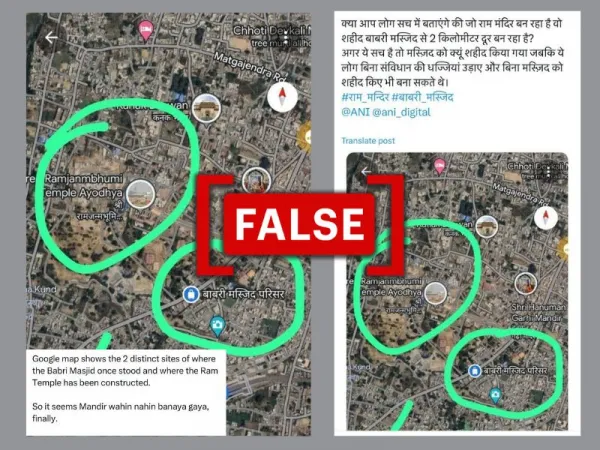By: Mohammad Salman
January 17 2024
No, Ram temple is not being built 3 km away from Babri Masjid demolition site

Screenshots of the viral post (Source: X/Screenshot/Modified by Logically Facts)
The Verdict False
The Ram temple in Ayodhya is not being built three kilometers away from the disputed site, but exactly where the demolished Babri Masjid was located.
What is the claim?
As the consecration date of the new Ram temple in Ayodhya approaches, various narratives and images with questionable claims are circulating online. A particular screenshot from Google Maps, making rounds on social media, alleges that the Ram Temple is being built not at the site of the demolished Babri Masjid, but three kilometers away.
This has raised questions about why the Babri Masjid was demolished if the Ram Temple was planned elsewhere. The viral screenshot appears to show two circled locations in green – the supposed current Ram Temple site and the former Babri Masjid location.
A user on X (formerly Twitter) shared this screenshot (archived here) with the caption, “Google Maps shows two specific sites where Babri Masjid once stood and where Ram Mandir has been constructed. So it seems that the temple was not built there after all.” Similar posts can be accessed here and here.
Screenshots of the viral post. (Source: X/Screenshot/Modified by Logically Facts)
Shiv Sena (Uddhav Thackeray faction) leader Sanjay Raut also commented on the matter, saying, “Where we were talking about building a temple, the temple has not been built there. That disputed place is still the same. The temple is built three kilometers away from there.”
Raut's statement was shared by Haryana Congress leader Vikas Bansal on X. An archived version of the post can be accessed here.
Screenshot of the viral post containing Sanjay Raut's statement. (Source: X/Screenshot)
However, our investigation reveals that the structure labeled 'Babar Masjid' on Google Maps is actually a Sita Ram temple, and the Ram temple in Ayodhya is indeed being erected at the site of the former Babri Masjid.
How did we find out the truth?
We started by searching both locations on Google Maps: one is labeled 'Shri Ram Janmabhoomi Mandir,' and the other 'Shri Sita Ram Mandir.' The latter is erroneously marked as 'Babar Masjid.'
Sita Ram temple visible in the viral screenshot and on Google Maps. (Source: X/ Google Map/Screenshot)
Zooming in on the 'Babar Masjid' in the viral screenshot on Google Maps, we discovered it leads to a structure named the Shri Sita Ram temple. We confirmed on Google Earth that the structure seen on the map is the same as the Sita Ram temple.
Shri Sita Ram Mandir visible in Google Maps (Source: Google Maps/Screenshot)
A separate search for ‘Babar Masjid' yielded an old image of Babri Masjid, which doesn't resemble the structure in the viral post. This indicates that the Sita Ram temple, located a distance from the new Ram temple site, has been inaccurately tagged as ‘Babar Masjid.'
Difference between the picture of ‘Babar Masjid’ and the picture of Google Satellite Image. (Source: Google Maps/Screenshot)
We then examined the Ram temple site on Google Earth Pro, observing a 2023 satellite image showing ongoing construction activity. When we tried to access old satellite images of the same place with the help of the historical imagery tool in Google Earth Pro, we came across a satellite image from 2011 where it can be seen that no construction work had started there at that time.
Satellite images of Ram Mandir in 2011 and 2023 (Source: Google Earth Pro/Screenshot)
Comparing old photographs of Babri Masjid with the 2011 satellite image from Google Earth Pro further confirmed that construction had not begun by then.
The verdict
Our investigation conclusively shows that the Shri Ram Janmabhoomi Temple is being constructed exactly where the Babri Masjid once stood. Therefore, we have marked this claim as false.
(Translated by: Rajini KG)


